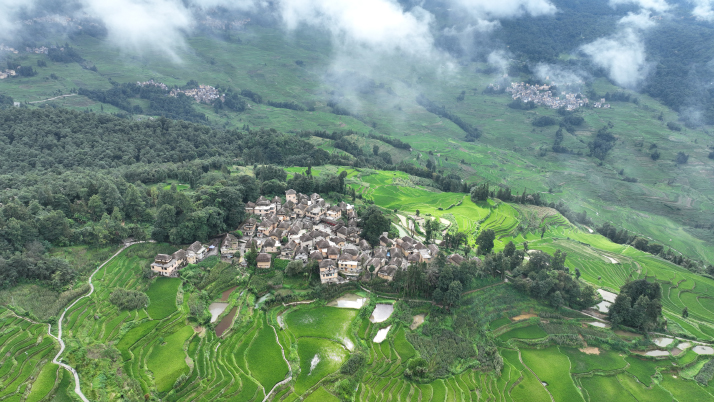| China |
| UN names seven villages in China among Best Tourism Villages | |
|
|
 Whooper swans in Yandunjiao Village, Rongcheng City, Shandong Province, on December 17, 2023 (XINHUA)
In winter, fishing villages are usually quite serene, but Yandunjiao Village in Lidao Town, Rongcheng City, Shandong Province, is remarkably vibrant, filled with the distinctive whooping of whooper swans (Cygnus cygnus), also known as common swans. "Though it's only 1 square km in area, the village attracts over 1,000 swans each year to spend the winter," explained Jiang Yuting, who works for the local government in Lidao, in an interview with Dazhong Daily, a Shandong-based newspaper. Rongcheng is China's largest winter habitat for whooper swans. Starting in October, nearly 10,000 swans migrate thousands of km from Siberia and Mongolia to winter in this region. Yandunjiao has become one of the city's primary gathering areas for these majestic birds. The swans have chosen Yandunjiao largely due to improvements in the ecological environment. Whooper swans have specific habitat requirements, and the village has taken proactive measures to improve their habitat by relocating seafood processing plants and shipyards away from the bay the swans and the village share. The local government organizes villagers to clean the shoreline each day and feed the swans corn, creating a welcoming environment. As the swan population in the village increased from a few dozen to hundreds, and then to 1,000, so too did the influx of tourists and photography enthusiasts. Yandunjiao has more to offer than just swans; it is also known for its unique seaweed-thatched houses. These traditional homes feature stone walls and roofs made of seaweed, which maintain warmth in winter and coolness in summer. Yandunjiao is now one of the few villages that boast a large number of well-preserved seaweed-thatched houses along the coast of Shandong. With a history of over 600 years, the village is home to more than 240 of the houses, some of which date back over 300 years. Protecting these seaweed-thatched houses is no simple task. The village has seven skilled craftsmen specializing in maintaining the roofs, supported by government funding exceeding 2 million yuan ($276,000) annually for repairs. "Since 2013, we have recognized seaweed-thatched houses with significant historical, cultural, and artistic value as protected cultural relics, implementing ongoing maintenance and preservation efforts," said Wang Hongchen, an official from Rongcheng City Culture and Tourism Bureau. Capitalizing on the village's growing popularity, the locals have started running homestays to accommodate tourists. More than 70 percent of the villagers are now involved in tourism, which has significantly boosted the local economy. Last year, the village welcomed over 500,000 tourists and its earnings from tourism exceeded 20 million yuan ($2.8 million). Yandunjiao is one of seven villages in China recognized in 2024 as Best Tourism Villages by the United Nations World Tourism Organization (UN Tourism). The announcement was made at a UN Tourism meeting held in Cartagena, Colombia, on November 15. China now has a total of 15 villages holding the Best Tourism Villages title, the highest number of any country. The other six Chinese villages recognized this year are Azheke Village in Yunnan Province, Guanyang Village in Fujian Province, Shibadong Village in Hunan Province, Taoping Village in Sichuan Province, Xiaogang Village in Anhui Province, and Xitou Village in Zhejiang Province. Distributed throughout the eastern, central, and western regions of the country, these villages exemplify the remarkable achievements of rural tourism development across China. The Best Tourism Villages initiative is a global program launched by UN Tourism in 2021, aimed at highlighting villages where tourism not only preserves cultures and traditions but also celebrates diversity, provides opportunities, and safeguards biodiversity.  Forests, traditional cottages and terraced rice fields among the clouds in Azheke Village in Yuanyang County, Honghe Hani and Yi Autonomous Prefecture, Yunnan Province, on July 19 (XINHUA)
Harmonious coexistence Azheke in Yuanyang County, Honghe Hani and Yi Autonomous Prefecture in Yunnan, was recognized as a Best Tourism Village for its well-preserved ecosystem and rich cultural heritage. The name "Azheke" translates to "a place where bamboo forests flourish" in the Hani language. For over 160 years, Azheke has been home to the Hani ethnic group. Situated on a mountainside, the village features a diverse and layered landscape, with forests, water systems, traditional thatched mushroom-shaped Hani houses, and terraced rice fields. The terraced fields were inscribed on the UNESCO World Heritage List in 2013 for exemplifying a resilient land management system that demonstrates extraordinary harmony between people and their environment. This relationship reflects the deep respect the Hani people hold for their environment. Despite the effectiveness of their land management practices, the village previously grappled with poverty, as most villagers relied heavily on smallholder farming, resulting in meager incomes. Many young people left to seek opportunities elsewhere, placing the village's traditional landscape and cottages at risk of disappearing. In 2018, professor Bao Jigang's team from the School of Tourism Management at Sun Yat-sen University in Guangzhou, Guangdong Province, was invited by the Yuanyang County Government to conduct field research in the village and developed the Azheke Plan. Under the plan, the county government and the village jointly established a tourism company responsible for managing the village's tourism development. Villagers receive 70 percent of the revenue generated from rural tourism, while the remaining funds support the tourism company's daily operations. To incentivize villagers to maintain their traditional dwellings and terraced fields, dividends will be reduced for those who neglect their mushroom-shaped houses or abandon their terraces. Following the implementation of this project, the village environment improved significantly, with the company employing villagers to clean facilities and collect litter left by tourists. The company has also coordinated the development of themed experiences for tourists, including farming workshops, weaving and dyeing sessions, wild vegetable picking, and visits to Hani homesteads. Villagers have engaged in tourism development and have seen a considerable increase in their income not only from the shared revenue, but also from access to new sources of income, such as selling foods and handcrafts, giving traditional performances, and working as tour guides and ticket sellers. (Print Edition Title: Top Towns for Tourism) Copyedited by G.P. Wilson Comments to jijing@cicgamericas.com |
|
||||||||||||||||||||||||||||||
|
